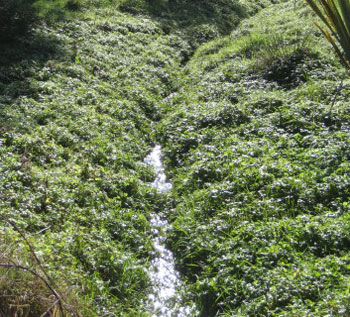We own and maintain a network of pipes and drains that form various stormwater drainage systems throughout our district. There are also many kilometres of open drains, creeks and streams on private property that the landowner is responsible to maintain.
The drains Council owns and maintains are referred to as public drains. Contact us if you want to know if the drain on your property or elsewhere is private or public.
Urban public stormwater drains
Council owns and maintains a public stormwater system to protect people and property from flooding. The urban stormwater system covers Gisborne city including Wainui and Okitu and the following rural residential areas:
| Hicks Bay | Manutuke | Matawai | Patutahi |
| Ruatoria | Tikitiki | Te Araroa | Te Karaka |
| Tokomaru Bay | Tolaga Bay | Te Puia Springs | Whatatutu |
In rural residential areas, the urban public stormwater system is mostly located between the 70km - 100km speed zone. The residential zone is also used to determine the urban/rural boundary.
The 'primary' urban stormwater system consists of around 140km of pipes with manholes, sumps and inlet/outlet structures. There are also drains, swales, sumps, channels and detention areas. The piped system is designed to cater for a 10-year storm event, or a 10% probability of this sized rain event occurring each year.
The ‘secondary’ stormwater system comes into action during significant heavy rain events. It consists of stormwater flow paths through reserves, private properties and alongside roads. It's designed to cater for a 100-year storm event, or a 1% probability of this sized rain event occurring each year.
There are just over 22km of significant streams, creeks and drains in Gisborne city that are maintained on a regular basis. Many other minor drains in Gisborne city and some townships are maintained on an ‘as required’ basis.
If you have a public drain on your property - don't damage, fill-in or interfere with the flow of water - contact us before you carry out any work.
If you have any questions about the public stormwater system, contact us.
Rural land drainage
Council owns and maintains a network of open drains across private farmland and adjacent to some roads.
A network of 330km of drains spanning 14 drainage schemes are maintained at the landowners request.
Yes, rural property owners can apply to get Council to maintain the drain.
Your neighbouring drain owners must also agree to join. Before the drain is added to the network, it may need to be upgraded to comply with our design standard.
Only when the drain complies with our standard, will Council take over responsibility to maintain it.
It would need to be a drain of strategic importance, generally serving multiple landowners.
You and your neighbouring landowners would then be rated for the additional service.
We spray public drains twice a year to keep weeds down. See information on spraying council drains.
If you have a public drain on your property - keep the weeds down so the water flows freely
Don't damage, fill-in or interfere with the flow of water - contact us before you carry out any work.
Roadside open drains on rural roads
Shallow roadside drains are watertable drains and in the winter months will have water in them.
They're designed primarily to take the water off the road.
If a roadside drain is blocked and flooding the road, please contact us.
You need approval before you carry out work in the road reserve, such as constructing a driveway, or installing a culvert.
See information on working in a road reserve, a Corridor Access Request.
Roadside open drains on a state highway
Along state highways the roadside drains in the 70km - 100km speed zone areas are maintained by Waka Kotahi Transport Agency (NZTA).
In the rural areas NZTA’s primary responsibility is to ensure the roadside drains protect the road from flooding.
Private stormwater drains
Drains that are not owned and maintained by Council or NZTA are classed as private - the landowner is responsible for the drain's maintenance.
If you have a private drain on your property - keep the weeds down so the water flows freely.
Don't damage, fill-in or interfere with the flow of water. Contact us before you carry out any work.
It's your responsibility to manage stormwater run-off on your property.
Building work such as raising the ground level, increasing hard surface areas or blocking an overland flow path could increase the amount of stormwater flowing onto a neighbour’s property.
It's your responsibility to manage stormwater falling naturally onto your property.
The best way to tackle a stormwater issue is to manage it as close to the source as possible, by reducing run-off and decreasing hard surface area.
You need a building consent to connect to Council's public stormwater drain.
See building consent information.
Spraying council drains
We maintain a network of 330km of Council open drains that run alongside roads and across private farmland.
Maintenance of the drains include spraying twice a year to keep them free from weeds. Keeping the weeds down helps keep stormwater draining and avoid flooding.
Our contractor sprays with a broad-spectrum herbicide - Glyphosate (Roundup™) in spring and autumn in the months of September to October and March to April.
We use Roundup™ as it is one of the safer chemicals to use in waterways.

We put signs up where we spray advising people not to pick watercress.
No picking watercress
It's not safe to pick any watercress from roadside drains or private property unless it's on your own land and you know that it's free of spray.
Also don't buy watercress unless you know where it has been picked from.
Be aware that farmers also spray their drains on the Poverty Bay Flats for weeds and they don't put signs up warning they have sprayed.